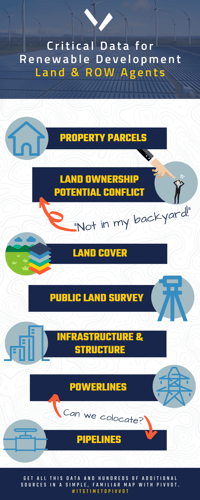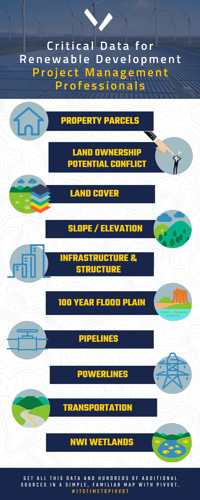Top Questions to Ask During Wind & Solar Site Selection
The solar and renewables industry is booming in the United States. Developers, real estate pros, and utilities are all looking to capitalize on the growth, and we're seeing a dramatic increase in wind and solar site selection projects.
With tax credits and benefits available in many states, renewable developers are racing to acquire land and begin to build. But, what exactly are they looking for when evaluating a site for a new project? What are the top variables they need to consider?
At Pivvot, we're location data and spatial analysis pros who have been building energy infrastructure for decades. Regardless of what you're building and where, we know what you need to look out for and what data you need depending on your role in the project.
We're going to share our top three questions to ask during renewable development siting and have included role-specific details in the downloadable infographics below.
1. Where is the closest substation?
The top question we need to answer is how we're going to get the energy generated from our site back to the grid. For every parcel of land we consider, we need to know if it intersects with an interconnect and what the least-cost route would be to connect.
Pivvot provides the critical data needed to evaluate existing infrastructure such as substations and powerlines, as well as the voltage that the existing assets can handle. It can also generate and analyze route scenarios to uncover potential issues earlier in the process.
2. Who owns this land?
Next, we need to know who owns the land to determine if it is available for our project. Is the land owned by the Federal government or a State? Is it a protected area or a historical site? If its owned by a private entity, how much do they own? Are there adjacent sites owned by the same person? Is it available for lease and how much is it?
Pivvot not only includes jurisdiction, boundary, and protected areas, it also include property parcel data in our simple, familiar map. In addition, Pivvot provides a direct link into our partner software, RealX, which is the largest online property rights exchange so developers and project managers can quickly asses what is available and how much it will cost.
3. What permits are required?
Last, we'll want to consider the permits needed to build on the parcel or site selected. It's crucial to know early on if you'll fall within a jurisdiction that results in a lengthy permit application. Top considerations include wetlands, 100-year and 500-year flood plains, and EPA protected waterbodies.
Pivvot provides hundreds of data sets including jurisdictions, boundaries, hydrology and geotechnical data. Additionally, we provide a list of the necessary permits you'll have to obtain triggered by data in your area of interest. You can quickly assess the environmental and permit landscape to understand scheduling impacts early and avoid delays.
There's always something...
Of course, there are many additional considerations and variables to evaluate when taking on a new energy project. Pivvot offers hundreds of data sets in a simple, fast and familiar location intelligence portal to streamline siting, suitability and permitting.
Using our decades of experience, we've identified the top data you'll need, depending on your role, for renewable development projects such as solar and wind siting. Click below to download the infographic most relevant to you. And, if you'd like to learn more, contact us today.




